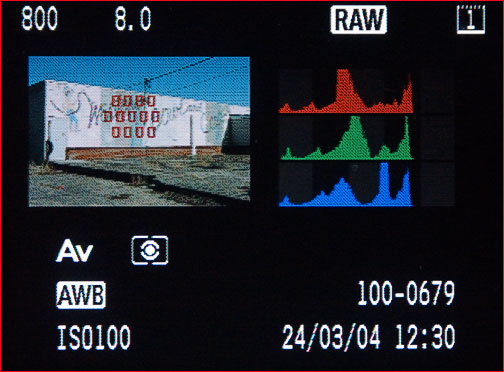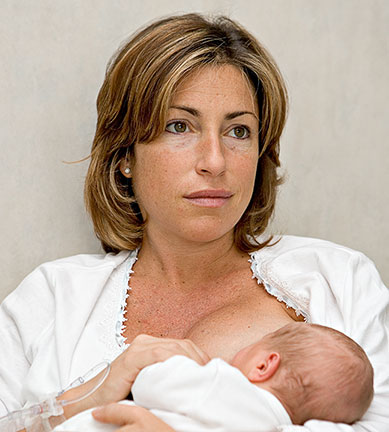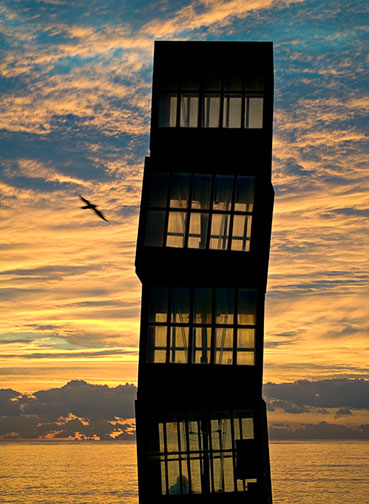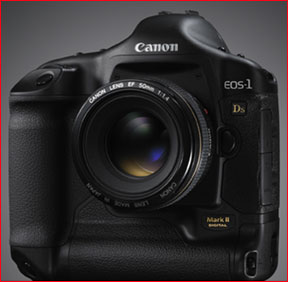
The number of times that I gotten a new camera for field testing the weekafter I get back from a shoot, are legion. They also often arrive when the weather is dreary, and my other commitments prevent a field shoot. But, sometimes the photography gods smile down upon us.
It was late October, and two hours before the car was scheduled to pick up my wife and me to head to the airport for a family visit in Barcelona, Spain.
"Michael. I finally have a review sample of the 1Ds Mark II for you. Do you want to pick it up tomorrow?"
ˆI’d love to, but I’m leaving for Europe in 2 hours."
Two hours later there was a knock on the door. It was the airport car service, and, happily,alsoa taxi driver holding a glossy Canon box. It had arrived in the nick of time. I quickly took the body, battery and charger out of its box, threw the manual in my briefcase, and headed out the door. All my wife could do was to shake her head knowingly.

Fishing – Barcelona. October, 2004
IDs Mark II with 70-300mm f/4.5 DO IS lens at ISO 400
The Canon 1 Series Progression
Canon’sOne Seriescameras are that company’s flagship. These are the most rugged, full-featured and fastest shooting cameras that Canon knows how to design and build. They are also a work-in-progress. Each new version builds on the one previous.
With the introduction of this new model, and with shipments to dealers beginning world-wide on 15 November, 2004, Canon now has three models of theOnein its line-up; the 1V film camera, the 1D Mark II, and the 1Ds Mark II. These Mark II models build on the strengths of their predecessors, each introduced about two years previous. They are also almost identical, with the exception of sensor size and shooting speed.
The 1D line is therefore bifurcated, with the 1D having an 8 Megapixel 1.3X factor sensor, providing 8 Megapixels of resolution, and the 1D Mark II full-frame 35mm, with a 16.7 Megapixel sensor. The 1D Mark II is therefore built for speed, while the 1Ds Mark II is designed for maximum image size.
My previous reviews of each of these cameras are found here:
16.7 Megapixels
There’s no denying it. A camera with a 16.7 Megapixels full-frame chip will likely cause any photographer’s heart to flutter. Such resolution has been the exclusive domain of $20,000 medium format backs for the past couple of years. Now, with the1Ds Mark IIwe have a complete high-end 35mm camera with a chip of that size that can shoot at 4 frames per second.
Of course this begs a few questions. In terms of image quality, how does the1Ds Mark IIcompare with, say, the 16 Megapixel Kodak DCS Pro Back on a Contax 645. And, is the extra resolution of the1Ds Mark IIa worthwhile upgrade over the 11 MP of its predecessor, the 1Ds? Finally, how does the1Ds Mark IIstack up in terms of image quality against a 22 Megapixel back such as the Phase One P25? (These aremypoints of comparison, because these are what I have and use. Another reviewer may have a different point of reference).
All of these questions will be answered in time, but first we need to look at the1Ds Mark IIin a bit more detail.
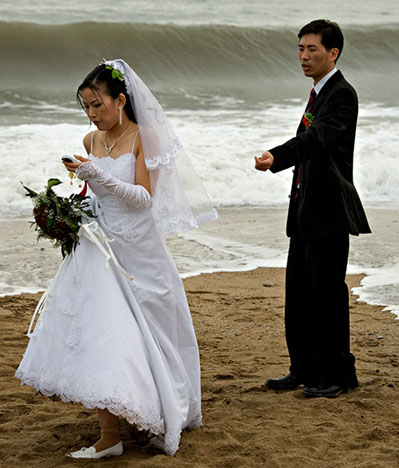
Beach Bride – Barcelona. October 2004
IDs Mark II with 70-300mm f/4.5 DO IS lens at ISO 400
Who We Are, And What It Is
Readers of this report will likely fall into two different categories; those that are owners of a previous generation 1D series body, and those for whom these are still a mystery. I won’t bore the initiated too much, I hope, with a review of the more basic features of this camera series. And, for those that have never held or used a Canon I Series camera, there are reviews on this site (links above) and elsewhere on the Net that will provide all the background that you might want. But before diving into the things that make the1Ds Mark IIunique, let’s look at a few of the digital 1 Series’ general attributes.
Firstly, the1Ds Mark IIis not like your everyday D-SLR when it comes to price; it retails for U.S. $8,000. Secondly, it’s about as full-featured a camera as anyone has every marketed. Thirdly, if you’re ever charged by a Rhino, use the1Ds Mark IIto smack him on the head. The Rhino will likely be stunned, while the1Ds Mark IIwon’t be. I know of 1 Series cameras that have fallen onto concrete from a height of 6 feet, been submerged fully under water for as long as 15 seconds, and which have been used from 120F in the desert to -35F in the Arctic, and emerged unscathed. Not to say that there likely aren’t equally robust cameras from other makers, or conversely, cameras that were damaged by simply tumbling off the couch onto a thick carpet. But in the main the Canon 1D Series can take whatever most photographers can hand out, and keep on ticking.
Metering is Canon’s most advanced, as is the 45 point autofocus. All buttons and openings in the body are rubber gasketed to keep out moisture and dust. The shutter mechanism is designed for a minimum of 150,000 actuations (upped to 200,000 on the1Ds Mark II). This is a couple of lifetimes of shooting by most amateurs, and a good 4-5 years by even the busiest professional. So, while photographers can ponder and debate the merits of a higher pixel count sensor and improved shooting speed, due to enhanced support electronics, the essence of the1Ds Mark IIremains unchanged. It is, in Canon’s idiom at least, the best picture taking machine that company knows how to make.
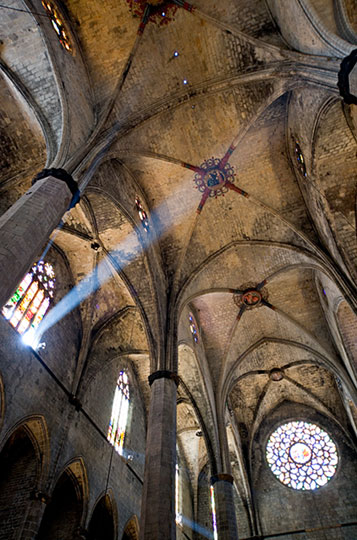
Santa Maria del Mare – Barcelona. October, 2004
Canon 1Ds Mark II with Sigma 12-24mm f/3.5. ISO 1000 @ 24mm
Features and Foibles
No E-1 Strap
In 2001 my 1Ds shipped with an E-1 wrist strap. The Mark II does not. Why, only Canon can say, but I see this as either a silly economy on Canon’s part, or an unfortunate oversight. The 1D series are large and heavy cameras, and after an hour or two of hand-held use the E1 becomes almost a must. If you’re going to be ordering a 1Ds Mark II, be sure to place an order for an E-1 handstrap at the same time. I regard it as a must-have for anyone working outside the studio.
Battery Life
When I received my test sample camera it had an installed and charged battery. I didn’t know its status, but I continued to use it for the next three days, taking almost 700 frames before the LCD status screen showed that it had dropped to one out of three bars. I had been using the review screen without concern for battery life, as well as using an IS lens for much of my shooting, and so I consider this to be excellent battery life. I’ll only be able to gauge true field battery life after several thousand frames in different temperature conditions, and different use cycles, but my preliminary assessment is that it is at least twice as good as the previous 1Ds, which I’ve become familiar with over the past 24 months.
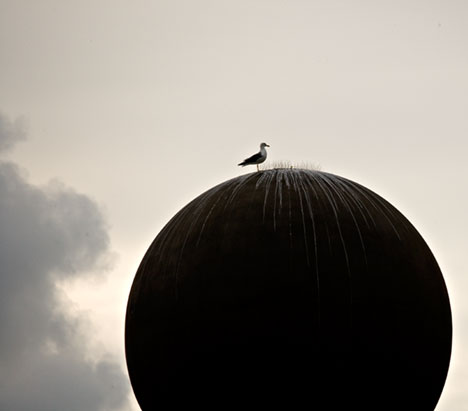
On The Ball – Barcelona. October, 2004
IDs Mark II with 70-300mm f/4.5 DO IS lens at ISO 200
Blank Frames
The camera which I received for testing had Firmware Version 1.0.0 installed. I encountered one bug during the week that I had the camera, and during which I took approximately a thousand frames. It recurred about once per day, and involved at least one RAW frame out of each hundred or so being unreadable, either by the camera, or by computer software.
I almost hesitate to mention this, because the camera tested was a pre-release sample, and this therefore may not be indicative of what initial purchasers can expect. So, if this is reported by users when cameras become generally available– yes, I experienced it too. If it isn’t, then ignore this paragraph and chalk it up to a minor pre-production software glitch.
Responsiveness
When Canon released the 1D Mark II earlier in 2004 the thing that impressed me the most, in addition of course to its extremely high frame rates, was its responsiveness. Compared to the 1Ds, which I had become used to, the 1D Mark II seemed almost intuitive. That same high level of responsiveness is now seen in the 1Ds Mark II.
There is hardly any lag between your wanting something to happen and its execution. Turn-on time is about a third of a second, about as fast as one can measure without a test bench. Shutter responsiveness is 1 Series fast, at about 55 milliseconds. And then there’s the frame rate. On theIDs Mark IIIt has been increased from just over 3 FPS to 4 FPS. Not a big deal, you may say, and not a patch on the 1D Mark II’s 8 FPS. But, nevertheless, it is an almost 33% increase in speed over its predecessor, and quite noticeable. For most photographers, other than those heavily involved in shooting sports (and some wildlife work), the frame rate of the 1Ds Mark II should prove more than adequate. And for them, there’s always the 8 FPS 1D Mark II.
Some people may therefore consider a 1D Mark II as their backup, especially for those times when high frame rates are needed. I though have decided to use the 5 FPS Canon 20D as my backup camera instead. Still not 8 FPS, but because of its smaller size, lighter weight and lower price, more appropriate formyneeds.
A Merger?
It seems to me that the bifurcation of the Canon 1D Series line between two model, differentiated only by imaging chip size and shooting rate, is a historical anomaly at best. In fact a European Canon executive recently implied this publicly.
The seperate 1D and 1Ds models exist because at this time the technology does not permit a full-frame 24X36 camera that can shoot at high enough frame rates to satisfy sports and other action photographers, and also at a low enough price. When Canon can make a 6–8 FPS full-frame body for under $5,000 I’m pretty confident that the 1.3X 1D variant will disappear. Photokina 2006 seems the most likely time.
CF and SD
Like the 1D Mark II predecessor of last Spring, the1Ds Mark IIcan take both Compact Flash and SD memory cards at the same time. The camera can be set to shoot to one, or the other, or both simultaneously. You can’t copy files between them in camera, and the camera won’t automatically switch to the other card when one gets full.
These seem to me to be arbitrary limitations. It certainly would make sense to be able to write RAW files to one card and JPGs to the other, Also, doing an in-camera back-up from one card to the other would be very convenient.

Scowl. Barcelona – October, 2004
IDs Mark II with 70-300mm f/4.5 DO IS lens at ISO 800
Other Features
Because the1Ds Mark IIis very similar to the 1D Mark II released just 6 months ago, I am re-using edited versions of some of the same items detailed on my original 1D Mark II review.
Autofocus
The processor that performs autofocus on the Mark II is rated as being twice as fast as that on the original 1Ds. I found autofocus to be highly accurate, but during the week I had the 1Ds Mark II for testing I really wasn’t shooting anything all that challenging. I’ll have more to write on this topic once I’ve done a wildlife shoot with it.
Chip Info
The1Ds Mark IIfeatures a Canon designed and manufactured 16.7 Megapixel CMOS chip of 24X36mm. Each pixel is 7.2 X 7.2 microns in size. These are smaller than on the 1Ds, and common wisdom is that smaller pixels produce more noise, But as will be seen, and as has been seen on the 20D vs. the 10D, good on-chip noise processing can sometimes trump larger pixel size.
Colour Histogram
This screen shot is of the 1D Mark II, but is used here because the display is identical between the cameras.Like the 1D Mark II, the1Ds Mark IIprovides a 3 colour histogram, with each channel shown as its own separate histogram next to a thumbnail of the image. It’s now possible to determine after taking a shot which channel might be blown out, and to take preventive measures. Of course a standard luminance histogram is also still available along with a flashing blown highlight warning.
LCD and Review
The LCD is much better than the one on the 1D or 1Ds. It is sharper and brighter, with almost double the resolution seen previously. There is also now the ability to magnify images while reviewing them without the silly Personal Function setting needed with the 1Ds. But, this is still not the best LCD screen around, and is difficult to see properly in bright light. I don’t understand why Canon’s flagship camera can’t have an LCD as good as that on some digicams. Canon – your top camera deserves a screen that can be viewed in bright daylight. Its time that you sourced a transreflective screen similar that that used by your competitors on their consumer cameras.
As with the 1D Mark II I was impressed with how fast the camera was able to display a post-exposure review image. On the 1Ds it takes about 3+ seconds from when the shutter is released until the image appears. On the Mark II it is on the screen by the time you’ve moved your head away from the eyepiece enough so as to be able to view the LCD — less than a second. This makes exposure adjustment using the post-exposure review histogram that much more intuitive and responsive.
Variable File Sizes
While many photographers want to shoot as large and high-resolution files as possible, many pros, especially newspaper photographers and photojournalist, make do with much smaller files. This is the case when these are destined for newsprint use, or for satellite or modem transfer.
The Mark II can shoot RAW, of course, and also JPGs in the following sizes…
Sizes in Megabytes
There is even a setting available to refine the JPG quality setting for each of the different sizes. It’s hard to imagine a photographer of any description who won’t be able to find a files size, quality setting, and other parameters that won’t meet his or her needs.
Saving Custom Settings
Most digital cameras can save one or two, or more custom settings in groups that can be recalled. While adding the ability to save custom settings (virtually every mode and setting that the camera has, including all Custom and Personal Functions), the Mark II takes a different road by writing these to the memory card instead of the camera’s nonvolatile memory.
This is a great feature for photographers working at studios, newspapers and magazines, where cameras are a shared resource. Simply saveyourcustom settings to a memory card and then the next time you pick upanycamera body of the same model just load them from the card. It just takes a couple of seconds. The camera is then right back to either the way you prefer to use it, or to a special configuration that you may have set.
My friend Andy Biggs, who conducts photographic safari workshop in Africa, and who shoots with a 1D Mark II, told me that on his last workshop there were several members shooting with the similarly featured 1D Mark II as well. Some were commenting that they weren’t sure how to set up all the camera’s multiple configurations. Andy simply wrote those from his camera to a card, and a few seconds later everyone in the group had their custom functions and basic settings configured in the same way. Cool.
My only complaint is that only one recording can be made to any one card. What a silly limitation. One way around this is to use low capacity and therefore inexpensive SD cards to store multiple custom setting profiles, and just load them in as needed. Of course the question needs to be asked – why Canon doesn’t also allow for saving one or more sets of profiles to nonvolatile memory in the camera, as other makers do on their consumer-grade cameras. This is an example of when a company places a great feature on its consumer models but neglects to provide it on the pro models.
Video Out
The 1D and 1Ds didn’t have video out capability. The Mark II models now do. This will be welcomed by photographers working in studio settings who want to be able to output to a TV monitor while reviewing shots taken.
I/O
The Firewire connection on the Mark II has been changed from 6 pin to the smaller 4 pin type style connector. This has made room for the connectors for both a USB 1.1 interface (for direct printing), and also for the new video-out connection.
The Firewire speed has also been increased, from 60 Mbps on the 1Ds, to 100Mbps on the Mark II.
E-TTL II
Canon’s flash metering system has been enhanced on the Mark II with the availability of what Canon calls E-TTL II. This takes into account distance information from the lens in calculating mixed flash and ambient conditions. I did a large number of exposures with the new Canon 580EX flash during my week of shooting with it in Spain, and found that the entire flash automation system was about as easy to use and foolproof as one could wish. I was often shooting a new mother and baby dressed in white, and found that while most exposures were right on, occasionally I needed to add about 1/3rd stop of flash exposure compensation. Balanced fill flash with available light was otherwise spot-on. Fill flash just doesn’t get much easier or better than this.
Caroline and Rio. Barcelona. October. 2004IDs Mark II with 28-70mm f/2.8L lens at ISO 200
Canon 580EX flash with mixed daylight,
using ceiling bounce and catch light card, in E-TTL II mode.IPTC JPGS
Of interest to photojournalists, the Mark II now writes IPTC data to JPGs rather than RAW files. It also now supports the EXIF 2.21 version, which adds Adobe RGB to the colour space information. This means that Photoshop automatically sees that the file is in the Adobe RGB colour space during loading.
Body Texture
It’s a small thing, but the Mark II has a slightly different body finish material than does the 1Ds. It’s finer grained and a little more "rubbery" feeling. Overall I think that this will make for a slightly firmer grip when ones hands are perspiring.
Card Door Latch
I’ve been razzed by some folks online for commenting in my reviews about how well, or poorly, cameras handle with gloves on. People with little experience of shooting extensively outdoors in inclement conditions simply don’t understand the importance of this aspect of camera design.
Canon does though, and they have specifically redesigned the latch on the memory card door so that it’s easier to open with gloves on. TheIDs Mark IIwill also not damage or lose your data if you accidentally open the card door while its being written to. When you close the cover it will resume writing to the card.
Auto-rotate
The1Ds Mark IIhas a body orientation sensor and can auto-rotate vertical images. This capability was almost unknown two years ago when the original 1Ds was introduced, while now it is fairly standard on cameras of all level. While this makes image processing that much swifter and convenient, when it comes to viewing image on the camera’s LCD screen, it really does make them awfully small. A trade-off, like many in photography.
Wireless LAN
For sports and news photographers the ability to transmit images directly from the camera to a nearby editor for rapid frame selection and processing has, till now, been the exclusive domain of Nikon. No longer. Though appealing only to a niche market, the addition of theWFT-E1Wi-Fi G transmitter will be appreciated.
By Comparison
There are three comparisons that I was interested in making when the1Ds Mark IIbecame available. The first was between it and its predecessor, the 1Ds. The second was between it and the Phase One P25, 22 Megapixel medium format back on a Contax 645 body. The third was between it and my 16 Megapixel Kodak DCS Pro Back.
The reasons for these particular comparisons was because these are devices that I either currently own and use, or will soon. Alas, the best laid plans of mice and photographers….
Of the three tests, only that between the1Ds Mark IIand Kodak DCS Pro Back was possible at the time that this is being written. My two year old 1Ds was enjoying a trip to Bangkok with its new owner, and my new Phase One P25 back was likely still sitting in a parts bin somewhere in Denmark, awaiting final assembly. But, the 1Ds will return soon, and the P25 will be here before mid-November, so I expect to be able to do both comparisons before the end of the month.
For the Kodak comparison test both camera systems were set up side-by-side on tripods. Mirror lock-up was used, and the cameras were set to ISO 100. Both camera meters provided an almost identical exposure (1/125 @ f/8). The light conditions werecloudy-bright.

The images are almost uncannily similar. Only their aspect ratio gives them away. Both were processed using Adobe’s Camera Raw. (In the case of the 1Ds Mark II, a beta version was used).
At ISO 100 I can see very little difference between the two files in terms of any visible characteristic, including noise, resolution, or dynamic range. Below are 100% crops of the two files. Other than a minute difference in colour and contrast these images areverysimilar. At this magnification the Contax / Kodak seems to show ever so slightly more detail, but on 13X19" prints this minute difference disappears.
A year ago, when I bought the Kodak back, the advantage in extra resolving power over the Canon 1Ds was pretty obvious. At the time, I wrote that it was about 30%. Today, the game has changed. And, if you’re wondering how other 16MP backs might compare, I doubt that any would perform all that differently in terms of resolution at this ISO. The lenses used would have a much more relevant effect, and in this case I don’t know of any medium format lenses better than the Zeiss lenses on the Contax.
This then bring up the issue of relative size. The jump from 11MP with the 1Ds to 16MP on the Mark II produces a 23% increase in resolution, and that is consistent with myseat-of-the-partsjudgement a year ago that the Kodak outresolved the 1Ds by about 30%.

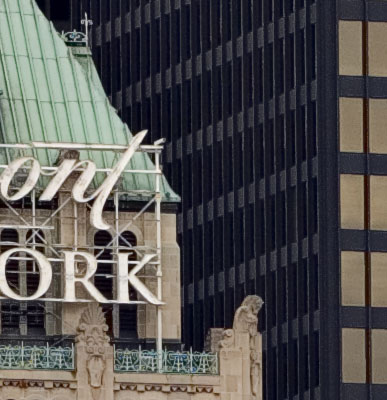
with Canon 70-200mm f/2.8L IS lens @ ISO 100
with Zeiss 120mm f/4 Apo Makro Sonnar @ ISO 100
But, what about at higher ISO settings? The frames below were shot at ISO 400. Both exposures were 1/700th at f/8. This is where the Canon really pulls into the lead. Noise on the Canon frame is visible here at 100%, but not objectionable. The Kodak back is quite a bit noisier, and if I were making a print of this shot I would want to run it through eitherNoise NinjaorNeat Image.
Update:
A few readers have commented that on their monitors the Canon images appear to have slight diagonal jaggies. These are not really there, and are likely an artifact of my trying to equalize the image sizes for web display. Since the problem was first discovered I have been on a location shoot, and do not have access to the original files. I’ll change them when I return. In the meantime, this doesn’t alter the visual comparison between these images, on screen or in prints.
Also, some readers have written to ask why the comparison was done between a zoom and a prime. The answer is because I didn’t have time to do more extensive testing with multiple lenses. But, I now have my own 1Ds Mark II (as of 16 Nov), and will be conducting a more in-depth series of tests and comparisons later in the month.

Surprisingly, on there isn’t much apparent difference in resolution on this particular test, given that the Contax was using a very highly regarded Zeiss WA prime lens, while the Canon was using a wide angle zoom.

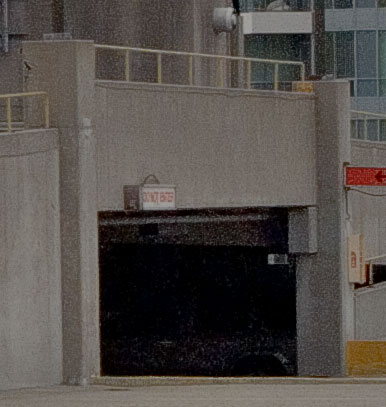
with Canon 16-35mm f/2.8L lens @ ISO 400
with Zeiss 35mm f/3.5 Distagon @ ISO 400
As far as dynamic range goes, there isn’t much separating these two systems. With the bright area of the sky showing comparable detail, so does the shadow detail (or lack thereof) in the darkened indoor garage.
The bottom line? An $8,000Canon 1Ds Mark IIcamera now provides image quality equal to or surpassing that of a $12,000 medium format back of just one year ago.
Colour Reproduction
TheMacbethcolour chart seen below was photographed under tungsten halogen lamps at 3200 deg. The gray point was set in Photoshop. Otherwise no changes have been made to the file. Comparisons are based on viewing the chart under a controlled light source. Please go by what I write, not by what you see, since web conversion, your monitor set-up, and a dozen other variable make it impossible to know whether what you’re seeing is the same as what I see. Evaluation of the computer file was done on aSony Artisanreference monitor.
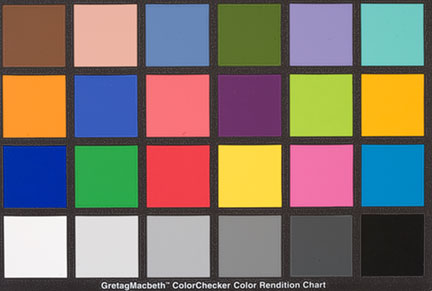
TheCanon 1Ds Mark IIreproduces the colour checker almost perfectly. The one area where it is a bit weak is with the red square, which seemed slightly undersaturated. Magenta also seemed ever so slightly less saturated than one might wish. Otherwise, colour accuracy on this camera is about as accurate as I’ve ever tested.
Noise
An Optical Analysis Using

The noise levels on the IDs Mark II are very low; comparable with those from the Canon 20D and 1D MKII, the best cameras over their entire range that I’ve yet tested or used. The surprise here is that ISO 50 (Low) is as poor as it is, about the same as ISO 800. Since the camera’s native ISO is 100, 50 ISO should therefore be regarded as a special purpose setting that really only should be used when an extra low shutter speed or wide aperture can’t be accomplished any other way. (Use an ND filter instead).
And yes, I did double check these results, because I was concerned that the ISO 50 result might be in error. It wasn’t.
With this generation of Canon camera I regard ISO 100-400 is being almost equally usable. Apparently Canon has reduced noise on this new chip by using larger microlens over each photosite, and has incorporated improved on-chip noise reduction circuitry.
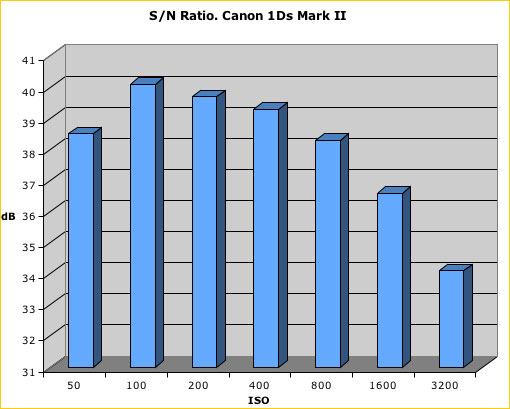
| ISO | Canon 1Ds Mark II |
| 50 | 38.5 |
| 100 | 40.1 |
| 200 | 39.7 |
| 400 | 39.3 |
| 800 | 38.3 |
| 1600 | 36.6 |
| 3200 | 34.1 |
Note that differences of 1dB or less are visibly insignificant.
Update:
Please note, and as I’ve written on these pages before, I do not find (in my set-up at least) that S/N measurements using DxO Analyzer are necessarily consistent over a long period of time. If this is indeed the case, they are best used for comparisons of a single camera at its various ISOs, rather than between cameras tested at different times. I am still investigating this.
It’s The Lenses – Stupid
When the 11 Megapixel 1Ds appeared I expressed concern that it could well be challenging Canon’s best lenses in terms of resolving power. I could clearly see differences when using some of my prime lenses, vs. several of the more popular zooms that we all use (including some L glass). Now with the 16 Megapixel 1Ds Mark II I believe that this is even more the case. It is all too easy though for one to become neurotic on the issue of lens quality. And, regular readers know that I consider convenience – which permits getting the shot over absolute quality concerns, to be of greatest importance. But, if you’re going to spring for a1Ds Mark II, and the reason is because you’re looking for the highest possible image quality, then bear in mind that this camera is going to require that you also buy the best glass for it. Also keep in mind that to really obtain the highest image quality that it is capable of, shooting technique also needs to be kept at the highest level.
Tower and Bird. Barcelona. October, 2004
IDs Mark II with 70-300mm f/4.5 DO IS lens at ISO 400
The Subjective Factor
There are many newcomers to photography, especially digital photography, who see cameras as something akin to a computer or wide-screen TV, where numeric analysis tells the full story. Well, maybe for some theConsumer’s Reportapproach is appealing. But for professional and ardent amateur photographers what tells the tale best about a camera is how it handles, along with the subjective image quality observed in prints.
On those measures, the1Ds Mark IIscores equally as well as it does on the test bench. This is possibly the most remarkable picture taking machine that I’ve yet used. It raises the bar with regard to operating speed as well as image quality.
Is it perfect? No, far from it. It’s big. It’s heavy, and it’s expensive. It also still infuriatingly requires 4 button presses to turn mirror-lockup on and off. (Hello Canon – please wake up and smell the coffee!)
The casual user (if there are any casual users of $8,000 cameras), will find that the user interface also requires a great many button presses to actuate just about every function. But most pros will welcome this, as it makes accidental settings that much less likely.
In the end, the1Ds Mark IIstands alone, (for the moment at least), as the camera with the combination of highest image quality and fastest handling available. There are faster cameras and there are higher resolution digital solutions (various 22 Megapixel backs, and soon the Mamiya ZD 22 MP camera). But for the money, the size, the versatility, and the performance, theCanon 1Ds Mark IIis currently king of the hill.
Coming Up
This test was based on using a pre-production camera for one week. The almost 1,000 frames shot told me a lot, but as most photographers will appreciate, it’s only after many thousands of frames shot in widely differing circumstances and environments that one can take the true measure of a sophisticated piece of equipment such as this.
I expect to be able to publish a comparison with the original 1Ds, and also against the Phase One P25, in the next couple of weeks, and will update my thoughts and experiences with the1Ds Mark IIonce I have a chance to use it more extensively in the field.
Michael H. Reichmann
Toronto – November 16, 2004
You May Also Enjoy...
Panasonic LX-3 Review
There aren't many truly pocket-sized digicams that offer raw mode. There aren't very many that currently offer decent HD video capability as well. There are
